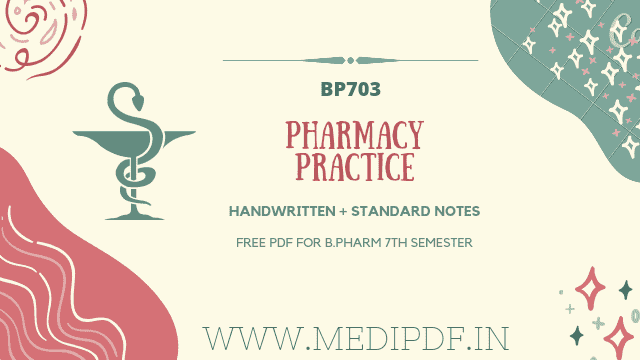Hello friends, in this post I have shared an overview and download links of notes of Pharmacy Practice (BP703T) according to the PCI syllabus for B Pharm 7th Semester 2023.
Overview
In the notes of Pharmacy Practice (BP703T), we have given two types of notes namely Handwritten notes and Standard notes.
Pharmacy Practice notes help in the evolving conditions for the pharmacy in India to ensure that they are effective in the hospital Pharmacy students have to acquire a variety of abilities, such as the distribution of medicines, information on drugs, and monitoring therapeutic drugs to guarantee the better treatment of patients. In the community pharmacy, students are taught a variety of methods including dispensing medication and dealing with minor illnesses by providing medical treatments as well as counseling to improve the treatment of patients in the community setting set up.
Friends In the Pharmacy Practice as per the syllabus copy of PCI B Pharm 7th semester, there are a total of 5 units in this subject.
Read this: B Pharma 7th Semester all Study Material PDF Free
Download Pharmacy Practice All Units Notes PDFs FREE
Click on the following download buttons below the names of the units to download Pharmacy Practice both Handwritten and Standard Notes.
In the Pharmacy Practice Notes Pdfs, the following chapters are explained in detail.
UNIT-1
a) The definition of the hospital’s structure and classification of hospital primary secondary and tertiary hospitals as in their classifications. It is based on a scientific or non-clinical base on the structure of an institution within the hospital, as well as the medical staff that is part of the institution and is responsible for their work.
b) It is the job of pharmacists in hospitals and its organization definition, the functions of the structure of the pharmacy in hospitals and layout, the needs of staff and layout, as well as the responsibilities and obligations of pharmacists who work in hospitals.
c) Classifications Excessive pharmacological reactions secondary pharmacological reactions, particular drug reactions, idiosyncrasies, and genetically-determined toxicity and toxicity after the abrupt removal of drugs Drug interactions positive interactions, negative interactions, and pharmacokinetic drug interaction methods for detecting drug interactions, cases that are spontaneously reported reports and study of the linkage between records and adverse reactions to drugs and their management.
d) Organization and design of retail and wholesale drug stores, their forms and designs, the legal conditions to establish and operate a retail store for the sale of drugs, the dispensing of proprietary products, and the maintenance of records for retail and wholesale drug stores.
UNIT-2
UNIT-3
a) Therapeutic committee and pharmacy Organization The roles, policies, and roles The Therapeutic Committee adopts include prescription drugs to the formulary, including prescriptions for outpatients and inpatients. Automatic stop orders, and an emergency list of medications.
b) Information on drugs, services 150 information about poisons and drugs centers and other information sources on drugs, and computerized services like the storage of data and its retrieval.
c) counseling for people (the idea that counseling services are offered to patients and the phases of counseling as well as situations where a pharmacist needs. To participate.
d) The education and training programs provided by the hospital. The pharmacist’s role in the education and training program, both external and internal, services to nursing homes and clinics, ethics codes for community pharmacists, and their role in interdepartmental communication as a public health professional.
e) Prescribed medication interpretation and legal requirements. Communication skills include communicating with prescribers and patients.
UNIT-4
A) The budget preparation process and the implementation of plans and budgets.
B) An introduction to the idea of clinical pharmacy. A pharmacist in a clinic fulfills the duties and roles of a pharmacist in a clinical setting. They keep track of the progress of therapy by keeping track of the medication chart and analyzing the clinical information and interventions of pharmacists and taking part in Ward Rounds. medications and pharmaceutical care. The treatment and dosage schedule will be determined by the drug’s pharmacokinetics and the patterns of disease.
C) Introduction to sales, as well as how prescription medications and the rationale use of prescription drugs generally.
UNIT-5
a) Management of the inventory in the shop. Control of the inventory of drug stores, kinds of supplies that are readily available, and the conditions for storage Controlling inventory and purchasing the fundamental principles that govern buying processes, purchase orders, and the economic value of stocking the purchase Reorder levels as well as the method employed to determine the cost of the drugs) The substances used in research The drugs used in research. Description, terms for use, classification, and management, and also the determination of the importance of pharmacists in an advisory panel for hospitals.
b) Analysis of Clinical Laboratory testing Blood Chemistry Hematology, and urine analysis.
When you’re pleased with these Pharmacy Practice notes, don’t forget to provide your comments in the comments area.

1 thought on “Pharmacy Practice Notes PDF Free”